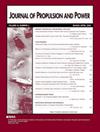预膜空气喷射器大涡模拟的拉格朗日模拟方法
IF 2.4
4区 工程技术
Q2 ENGINEERING, AEROSPACE
引用次数: 0
摘要
提出了一个拉格朗日框架来解决航空空气喷射器大涡模拟中的液膜和雾化建模问题。O 'Rourke和Amsden的拉格朗日液膜模型(“KIVA-3壁膜模型的喷雾/壁相互作用子模型”,SAE International TP 2000-01-0271,宾夕法尼亚州沃伦代尔,2000)通过引入子网格接触角来更好地预测膜高度和所产生的膜动力学,从而改进了拉格朗日液膜模型。接下来,Chaussonnet等人提出的预膜空气喷射器(PAMELA)的初级雾化模型(“预测大涡模拟空气喷射器滴度分布的新现象学模型”,《国际多相流杂志》,第80卷,2016年4月,第29-42页)在预膜器边缘的初级雾化得到增强,以处理复杂的几何形状。该模型能够根据预膜高度和流动条件预测液滴大小的概率密度函数。最初的公式依赖于对平板有效的相关性来确定气体边界层厚度,并且需要用户设置膜高度处的气体速度。这两点使得它很难用于复杂的结构,因为气体边界层厚度没有简单的相关性,而在膜高度处的气体速度不能先验地估计。因此,在这项工作中提出了一种嵌入式方法,称为自动PAMELA,以自动确定仿真中的这两个量。对于发生雾化的预膜边缘的每个单元,利用拉格朗日探针通过分析局部速度分布来估计气体边界层厚度;通过假设一个对数速度剖面,从局部膜高度计算气速。最后,将膜状雾化模型和一次雾化模型与二次雾化模型进行了耦合,并在一个工业鼓风航空喷油器上进行了评价。将平均液滴速度分布和Sauter平均直径与实验相位多普勒粒子分析仪的测量结果进行了比较,证明了所提出的框架在复杂几何形状下进行液体注入的拉格朗日LESs的能力。本文章由计算机程序翻译,如有差异,请以英文原文为准。
Lagrangian Simulation Methodology for Large-Eddy Simulations of Prefilming Air-Blast Injectors
A Lagrangian framework is proposed to address liquid film and atomization modeling in large-eddy simulations (LESs) of aeronautical air-blast injectors. The Lagrangian liquid film model of O’Rourke and Amsden (“A Spray/Wall Interaction Submodel for the KIVA-3 Wall Film Model,” SAE International TP 2000-01-0271, Warrendale, PA, 2000) is improved by introducing a subgrid contact angle to better predict the film height and the resulting film dynamics. Next, the phenomenological the primary atomization model for prefilming air-blast injectors (PAMELA) proposed by Chaussonnet et al. (“A New Phenomenological Model to Predict Drop Size Distribution in Large-Eddy Simulations of Airblast Atomizers,” International Journal of Multiphase Flow, Vol. 80, April 2016, pp. 29–42) for primary atomization at the prefilmer edge is enhanced to deal with complex geometries. This model is able to predict the droplet-size probability density function from the prefilmer height and flow conditions. The original formulation relied on correlations valid for flat plates to determine the gas boundary-layer thickness, and it required a gas velocity at film height to be set by the user. These two points make its use difficult for complex configurations where there is no simple correlation for the gas boundary-layer thickness and the gas velocity at film height cannot be a priori estimated. An embedded methodology, named the automatic PAMELA, is therefore proposed in this work to automatically determine these two quantities in the simulation. For each cell of the prefilmer edge where atomization occurs, the gas boundary-layer thickness is estimated by analyzing the local velocity profile thanks to Lagrangian probes; and the gas velocity is computed from the local film height by assuming a logarithmic velocity profile. Finally, the film and primary atomization models are coupled to a secondary atomization model, and they are assessed on an industrial air-blast aeronautical injector. The average droplet velocity profiles and Sauter mean diameters are compared against experimental phase Doppler particle analyzer measurements, and they demonstrate the ability of the proposed framework to perform Lagrangian LESs of liquid injection in complex geometries.
求助全文
通过发布文献求助,成功后即可免费获取论文全文。
去求助
来源期刊

Journal of Propulsion and Power
工程技术-工程:宇航
CiteScore
4.20
自引率
21.10%
发文量
97
审稿时长
6.5 months
期刊介绍:
This Journal is devoted to the advancement of the science and technology of aerospace propulsion and power through the dissemination of original archival papers contributing to advancements in airbreathing, electric, and advanced propulsion; solid and liquid rockets; fuels and propellants; power generation and conversion for aerospace vehicles; and the application of aerospace science and technology to terrestrial energy devices and systems. It is intended to provide readers of the Journal, with primary interests in propulsion and power, access to papers spanning the range from research through development to applications. Papers in these disciplines and the sciences of combustion, fluid mechanics, and solid mechanics as directly related to propulsion and power are solicited.
 求助内容:
求助内容: 应助结果提醒方式:
应助结果提醒方式:


